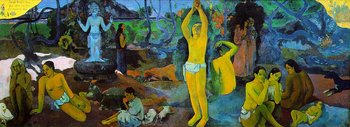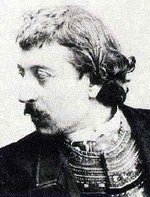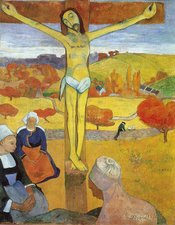Paul Gauguin
|
|
Eugène Henri Paul Gauguin (June 7, 1848 - May 9, 1903) was a leading Post-Impressionist painter. His bold experimentation with coloring led directly to the Synthetist style of modern art.
Born in Paris, France, he descended from Spanish settlers in South America and the viceroy of Peru, and spent his early childhood in Lima. He was the grandson of Flora Tristan, a founder of modern feminism. After his education in Orléans, France, Gauguin spent six years sailing around the world in the merchant marines and then in the French navy. Upon his return to France in 1870, he took a job as a broker's assistant. His guardian Gustave Arosa, a successful businessman and art collector, introduced Gauguin to Camille Pissarro in 1875.

1897, oil on canvas
Boston Museum of Fine Arts, Boston, MA, USA
A successful stockbroker during week-days, Gauguin spent holidays painting with Pissarro and Cezanne. Although his first efforts were clumsy, he made visible progress. By 1884 Gauguin had moved with his family to Copenhagen, where he unsuccessfully pursued a business career. Driven to paint full-time, he returned to Paris in 1885, leaving his family in Denmark. Without adequate subsistence, his wife and children returned to her family.
Like his friend Vincent Van Gogh, with whom he spent nine weeks painting in Arles, Paul Gauguin experienced bouts of depression and at one time attempted suicide. Disappointed with Impressionism, he felt that traditional European painting had become too imitative and lacked symbolic depth. By contrast, the art of Africa and Asia seemed to him full of mystic symbolism and vigour.
Under the influence of folk art and Japanese prints, Gauguin evolved towards the manner he called Cloisonnism. In The Yellow Christ (1889), often cited as a quintessentual Cloisonnist work, image was reduced to areas of pure colour separated by heavy black outlines. In such works Gauguin paid little attention to classical perspective and boldly eliminated subtle gradations of colour — he dispensed with the two most characteristic principles of post-Renaissance painting.
In 1891, Gauguin, frustrated by lack of recognition at home and financially destitute, sailed to the tropics to escape European civilization and "everything that is artificial and conventional." He remained first in Tahiti and later in the Marquesas Islands for most of the rest of his life, returning to France only once. His works of that period are full of quasi-religious symbolism and an exoticized view of the inhabitants of Polynesia.
He is buried in Calvary Cemetery (Cimetière Calvaire), Atuona, Hiva ‘Oa, Marquesas Islands, French Polynesia.
Ta_matete.jpg
1892, oil on canvas
Legacy
The vogue for Gauguin's work started soon after his death. Many of his later paintings were acquired by the Russian collector Sergei Shchukin. A substantial part of his collection is displayed in the Pushkin Museum. Gauguin paintings are rarely offered for sale; their price may be as high as $39.2 million.
In 2003, the Paul Gauguin Cultural Center opened in Atuona in the Marquesas Islands.
Paul Gauguin's life inspired Somerset Maugham to write The Moon and Sixpence.
List of paintings
Paul_Gauguin_071.jpg
Paul_Gauguin_056.jpg
Paul_Gauguin_025.jpg
- The Seine in Paris between the Pont d'léna and the Pont de Grenelle (1875)
- The Seine at the Pont d'Iéna, Snowy Weather (1875)
- Apple-Trees in Blossom (1879)
- Effect of Snow (1879)
- Portrait of Gauguin's Daughter Aline (c.1879-80)
- Study of a Nude. Suzanne Sewing (1880)
- Aube the Sculptor and His Son (1882)
- At the Window (A la fenêtre) (1882)
- Mandolina and Flowers (1883)
- Bouquet (1884)
- Cattle Drinking (1885)
- Still Life with Mandolin (1885)
- Study for the Bathers (1886)
- The Four Breton Girls (1886)
- Breton Shepherdess (1886)
- Washerwomen at Pont-Aven (1886)
- At the Pond (1887)
- Huts under Trees (1887)
- Palm Trees on Martinique (1887)
- Head of a Negress (1887)
- Madame Alexandre Kohler (c.1887-88)
- Still Life with Three Puppies (1888)
- Breton Girls Dancing, Pont-Aven (1888)
- Breton Girls Dancing (1888)
- Madeleine Bernard (1888)
- Vision after the Sermon; Jacob Wrestling with the Angel (1888)
- Night Café at Arles (1888)
- Van Gogh Painting Sunflowers (1888)
- Women from Arles in the Public Garden, the Mistral (1888)
- Hay-Making in Brittany (1888)
- Bouquet of Flowers with a Window Open to the Sea (Reverse of Hay-Making in Brittany) (1888)
- The Alyscamps (1888)
- Harvesting of Grapes at Arles (Misères humaines) (1888)
- Fruits (1888)
- Ceramic Vase with a Caricature Self-Portrait (1889)
- Bonjour, Monsieur Gauguin (1889)
- Still Life with Fan (1889)
- The Schuffenecker Family (1889)
- The Yellow Christ (1889)
- Caricature Self-Portrait (1889)
- Self-Portrait with Yellow Christ (1889)
- Ondine (1889)
- Yellow Hay Ricks (Fair Harvest) (1889)
- Nirvana, Portrait of Meyer de Haan (1889)
- La Belle Angèle (Portrait of Madame Satre) (1889)
- Be in Love and You Will Be Happy (1889)
- Eve. Don't Listen to the Liar (1889)
- The Yellow Christ (Le Christ jaune) (1889)
- Study for La perte de Pucelage (The Loss of Virginity) (c.1890-91)
- Mimi and Her Cat (1890)
- Portrait of a Woman with Cézanne Still-Life (1890)
- Haystacks in Brittany (1890)
- Landscape (1890)
- Ia Orana Maria (Hail, Mary) (1891)
- Vahine no te tiare (Woman with a Flower) (1891)
- Te Faaturuma (Brooding Woman) (1891)
- Les Parau Parau (Conversation) (1891)
- The Meal (The Bananas) (1891)
- Tahitian Women (on the Beach) (1891)
- The Fisherwomen of Tahiti (1891)
- Black Pigs (1891)
- Self-Portrait (1891)
- Self-portrait (1891)
- Head of a Woman (c.1891-92)
- Vaïraumati tei oa (Her Name is Vairaumati) (1892)
- Manao tupapau (The Spirit of the Dead Keeps Watch) (1892)
- Aha oe feii? (Are You Jealous?) (1892)
- Fatata te miti (Near the Sea) (1892)
- Musique barbare (c.1891-93)
- Parau Api (What's New?) (1892)
- Vahine no te vi (Woman with a Mango) (1892)
- Ta Matete (We Shall Not Go to the Market Today) (1892)
- Piti Teina. (Two Sisters) (1892)
- Taperaa Mahana (1892)
- Joyeuseté (Arearea) (1892)
- Tahitian Eve (c.1892)
- Words of the Devil (c.1892)
- Nafea Faa ipoipo? (When Will You Marry?) (1892)
- Study for "When Will You Marry?" (c.1892)
- Fatata te mouà (At the Foot of a Mountain) (1892)
- Self-Portrait (c.1890s)
- Matamoe (Landscape with Peacocks) (1892)
- Parau na te varua ino (Words of the devil) (1892)
- Merahi metua no Tehamana (Ancestors of Tehamana) (1893)
- Aita Tamari vahina Judith te Parari (Annah the Javanese) (1893)
- Te Tiare Farani (Bouquet of Flowers) (1893)
- Pastorales Tahitiennes (1893)
- Eü haere ia oe (Woman Holding a Fruit) (1893)
- Tahitian Landscape (1893)
- The Messengers of Oro. Illustration for 'L'Ancien culte mahorie', leaf 24 (1893)
- Pape Moe (Mysterious Water) (1893)
- Self-Portrait (c.1893-94)
- Portrait of William Molard. Reverse of Self-Portrait (c.1893-94)
- Floral and Vegetal Motifs (1893)
- Tahitian Woman in a Landscape (1893)
- Breton Landscape (The "Moulin David") (1894)
- Breton Village in Snow (1894)
- Portrait of Mother (1894)
- Siesta (1894)
- Two Breton Women on the Road (1894)
- Head of Young Breton Peasant Woman (c.1894)
- The Cellist (Portrait of Upaupa Scheklud) (1894)
- Mahana no atua (Day of God) (c.1894)
- Nave Nave Moe (Sacred Spring) (1894)
- Ceramic vase with Tahitian Gods - Hina and Tefatou (c.1894-95)
- Vairumati (1896)
- Te arii vahine (The King's Wife) (1896)
- Self-Portrait (1896)
- No te aha oe riri? (Why Are You Angry? (1896)
- Eiaha Ohipa (Not Working) (1896)
- Still Life with Mangoes (1896)
- Scenes from Tahitian Life (1896)
- Bouquet of Flowers (1896)
- Te Arii Vahine (Queen) (1896)
- Self-Portrait (1896)
- Te Vaa (The Canoe) (1896)
- Te Tamari No Atua (Nativity) (1896)
- Baby (The Nativity) (1896)
- Tarari maruru (Landscape with Two Goats) (1897)
- Man Picking Fruit from a Tree (1897)
- Nevermore, O Taiti (1897)
- D'où venons nous? Que sommes-nous? Où allons-nous? (Where Do We come from? What Are We? Where Are We Going?) (1897)
- The White Horse (1898)
- Rave te hiti aamy (The Idol) (1898)
- Te Pape Nave Nave (Delectable Waters) (1898)
- Horse on Road. Tahitian Landscape (1899)
- Motherhood (Women on the Shore) (1899)
- Te avae no Maria (Month of Maria) (1899)
- Three Tahitian Women Against a Yellow Background (1899)
- The Great Buddha (1899)
- Two Tahitian Women with Mango Blossoms (1899)
- Three Tahitians (1899)
- Tahitian Woman (c.1900)
- Ford (Running Away) (1901)
- Sunflowers (1901)
- Tahitian Idyll (1901)
- And the Gold of Their Bodies (Et l'or de leurs corps) (1901)
- The Call (1902)
- Girl with a Fan (1902)
- Horsemen on the Beach (1902)
- Barbarous Tales (1902)
- Adam and Eve (1902)
- Still Life with Parrots (1902)
- Mother and Daughter (1902)
- Haere Mai (date unknown)
- In the Vanilla Grove, Man and Horse (date unknown)
External links
Template:Wikiquote Template:Commonscat
- Paul Gauguin (http://www.fantasyarts.net/Gauguin.htm) Biography and Paintings
- All paintings from Paul Gauguin (http://www.wooop.com/impressionism/Paul_Gauguin/)
- Paul Gauguin at Olga's Gallery (http://www.abcgallery.com/G/gauguin/gauguin.html)de:Paul Gauguin
es:Paul Gauguin fr:Paul Gauguin fy:Paul Gauguin ko:폴 고갱 it:Paul Gauguin he:פול גוגן hu:Paul Gauguin nl:Paul Gauguin ja:ポール・ゴーギャン pl:Paul Gauguin pt:Paul Gauguin ro:Paul Gauguin ru:Гоген, Поль sl:Paul Gauguin fi:Paul Gauguin sv:Paul Gauguin uk:Ґоґен Поль zh:保羅·高更


